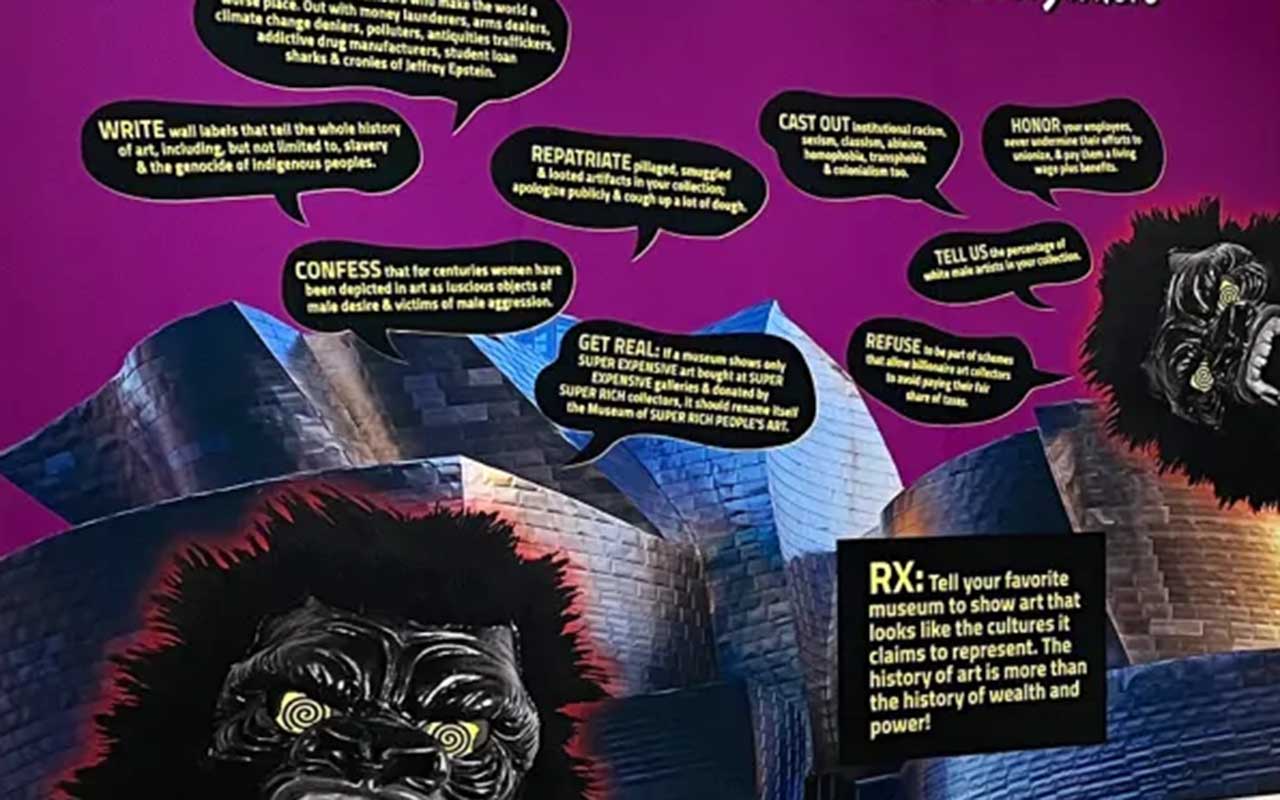Looking at Discrimi-NATION: Guerrilla Girls on Bias, Money, and Art, the one-room mini-retrospective of posters by the Guerrilla Girls currently at Hannah Traore Gallery, at this moment in history, raises the questions: What can be learned from this work that can be applied to the present? And is this an effective method of making change?
The Guerrilla Girls began as an anonymous feminist art and activism collective in 1985. Members’ wear gorilla masks when appearing in public and their real names and identities have remained a tightly guarded secret over the past 40 years. People have cycled in and out of the collective over the years, but their work and influence remain steadfast. Though they have mounted exhibits, engaged in live interventions and performances, given countless talks, and produced videos, the group is most famous for their posters, in which they denounce the art world, particularly galleries and museums, through straightforward data and bombastic text and imagery to reveal the obvious gender- and race-based biases that are still widespread in the field.
In their earliest actions, they wheat-pasted black and white posters around the Lower East Side and Soho in New York City. The work was characterized by bold, advertising-inspired typography and statistical evidence of the lack of art by women appearing in the city’s galleries and museums. Soon after, they brought their message directly into exhibition spaces, organizing a show of artwork by women at the Palladium Dance Club in 1985, and in 1987, participating in two gallery shows — including one in which they skewered the Whitney Biennial (and the Whitney Museum in general) for its history of excluding women and artists of color, as well as the museum’s board members’ and donors’ attempts to cleanse their personal and corporate sins through what we would now call “artwashing.” Since that time the use of clear-cut statistics, bold graphics and typography, and large format posters has become the Guerrilla Girls’ signature.

While their message has remained consistent, it has expanded to address more of the persistent issues facing the art world. For instance, the nearly 10-by-10-foot poster that anchors the show, “Guerrilla Girls ManifestA: For Art Museums Everywhere” (2024), features their iconic gorilla masks snarling atop a photo of the Guggenheim Bilbao in Spain. This work encourages viewers themselves to determine the percentage of work by White male artists in museums, to pay attention to funding sources, to support museum workers, to repatriate stolen artifacts, and to “Tell your favorite museum to show art that looks like the culture it claims to represent.”
The simple but powerful gesture of taking a literal account of who does and doesn’t have a place in and influence on art institutions’ walls clearly taught generations of activists, artists, and writers a methodology, including myself. In fact, my first text for this publication, back in 2012, jumped off from a provocative data collection project by W.A.G.E. I added my own data collection to the article, reaching out to numerous artists in that year’s Whitney Biennial to confirm that they had not been paid by the institution — a fact that many suspected to be true at the time, but few discussed openly. Today, thanks to persistent activism by groups like W.A.G.E., and greater attention drawn to the inner workings of the Biennial, participating artists are paid. But as the Guerrilla Girls’ posters reveal, change is too often slow, marginal, or both.
The group’s methodology is so widely adapted at this point that their more contemporary posters can feel a bit behind the curve. For instance, a 2016 poster highlighting the predominance of White cis male Academy Award winners feels a bit late on the scene given the success of the #OscarsSoWhite movement across social media and in the press starting in 2015, though the poster was an update of the group’s first “Anatomically Correct Oscar” billboard, produced for the 2002 Academy Awards.

There’s also the reality that by focusing on the numbers, they risk encouraging the kind of tokenism that they themselves have warned against. The autumn after the George Floyd protests erupted nationwide, portraiture and figuration by Black artists and of Black subjects showed up in gallery after gallery in New York City. While that moment provided long-overdue attention to a lot of deserving artists, it was hard to ignore the cynical dimension as many galleries attempted to artwash their own sins and omissions. Activists like the Guerrilla Girls are in no way responsible for such tokenism, but it begs the question of how to push for change using fixed identity categories without trapping artists within institutional expectations of what it means to perform those same identities.
Revisiting their work at this moment feels useful and important, but it is also a reminder that for these kinds of pressure campaigns to produce results, those in power must be ashamed of their behavior or worried enough about saving face with funders and buyers that they change. Today we live in a world where many of those who control the levers of national power have made it clear that they are unashamed of their baldly self-interested moves to preserve and uphold White supremacy and patriarchy. Public record keeping will continue to tell a history that should be preserved and returned to. But if we want change in the present, it’s clear that we need new tactics that go beyond the gathering of data and either force the hand of those controlling these institutions or forge paths entirely outside of the dogged money-driven interests of those spaces.



Discrimi-NATION: Guerrilla Girls on Bias, Money, and Art continues at Hannah Traore Gallery (150 Orchard Street, Lower East Side, Manhattan) through March 29. The exhibition was organized by the gallery.
Editor’s Note, 2/7/2025, 4:25 pm EST: An earlier version of this article did not mention a 2002 Guerrilla Girls poster. This has since been updated.

